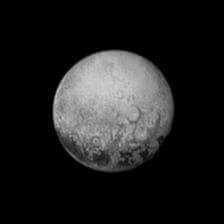What Makes the New Horizons’ Encounter With Pluto So Extraordinary?
The New Horizons mission to Pluto provides the most detailed view of the dwarf planet that humans have ever seen. How have scientists reached the outer limits of our Solar System, and what do we expect to learn? Find out how to get news from the spacecraft and follow its upcoming close encounter with Pluto.
Sabrina Stierwalt, PhD
Listen
What Makes the New Horizons’ Encounter With Pluto So Extraordinary?
July 14th 2015, marks a historic day in the history of space exploration. Scientists and astronomy lovers all over the world will breathlessly await news from the New Horizons spacecraft to learn whether or not the probe survived its close encounter with Pluto and to get a look at the most detailed view of the dwarf planet that humans have ever seen.
Pluto was discovered in 1930 because it moved relative to the surrounding background stars in a series of optical images. Astronomers were looking for the mysterious Planet X, a planet whose presence was predicted in order to explain apparent irregularities in the orbits of Uranus and Neptune. Although Pluto’s orbit was a good match to that predicted for Planet X, Pluto was determined to be much too small to have such a strong gravitational effect on the gas giants. The closer look at Uranus and Neptune offered by the Voyager 2 spacecraft later revealed the orbital anomalies to be based on miscalculations, and thus the search for Planet X was largely called off.
Pluto was later famously demoted from its status as the ninth and most distant planet in our solar system to that of a dwarf planet. In addition to rendering all of my childhood astronomical drawings wrong, this change in classification reflected our increasing understanding of our solar system. A dwarf planet cannot clear other objects out of its path, and Pluto was discovered to be part of the Kuiper Belt, a larger system of rocky, icy bodies orbiting the Sun at distances beyond the orbit of Neptune.
At 1,400 miles wide (about half the length of the U.S. and smaller than our Moon), Pluto is the largest known object in the Kuiper Belt. The Kuiper Belt is similar to the Asteroid Belt between Mars and Jupiter in that both are understood to be made up of remnants left over from the formation of our solar system.
Pluto has five known moons: Charon, Nix, Hydra, Styx, and Kerberos. Pluto and Charon, the largest moon, were thought to have collided before forming the system that we observe today.
New Horizons, a piano-sized spacecraft that began its journey from Earth back in January of 2006, will make its closest approach with Pluto at 11:49:57 UTC (that’s 07:49:57 EDT) on Tuesday, July 14, 2015. That adds up to a nine and a half year wait since the spacecraft was launched. That’s like preparing a pie—one with ingredients that cost you several hundred million dollar—and carefully placing it in the oven, only to know that you can’t enjoy the result for another nine and a half years.
Such long travel times are needed because Pluto makes its home in the distant outskirts of our solar system. The orbit of Pluto is so large that one year on the dwarf planet, i.e. the time it takes Pluto to make one full trip around the Sun, is the equivalent of 248 Earth years. To learn more about the distance from Pluto to the Sun and other fun Pluto numbers, check out last week’s episode from The Math Dude.
Here are five reasons New Horizons’ close encounter with Pluto is truly extraordinary.
We have one (very brief) chance to get it right.
Pluto is so far that even taking as long as nine and a half years to get there requires some pretty high speeds. New Horizons gets roughly 1.2 million kilometers closer to Pluto every day and will zoom by at 30,800 miles per hour (or 49,600 kilometers per hour).
To put these speeds in perspective, remember that Apollo astronauts took three days to reach the Moon. New Horizons made the trip in only nine hours. At closest approach, the spacecraft will still be about 7,800 miles from Pluto (or about 12,500 kilometers).
Since only a flyby is planned, and not multiple orbits of the dwarf planet, the seven instruments aboard the spacecraft will have only one brief shot at collecting their data during the close encounter. The quick pass, along with the fact that Pluto and Charon orbit each other slowly, about once every 6 days, also means that only the northern hemisphere will be seen during the closest approach.
Scientists are prepared in case New Horizons doesn’t survive its close encounter with Pluto.
Alan Stern, the Principle Investigator for the New Horizons mission has stated that “if the spacecraft were hit by something even the size of a rice pellet, it could pierce into the spacecraft, and potentially cause it to stop functioning. It would be like colliding with a brick at 60 miles an hour.”
Thus, astronomers are hoping that Charon, Pluto’s largest moon, has cleared out any errant debris as it moves in its orbit with Pluto. Just in case, however, the spacecraft sent its last downlink of data before the close approach on July 12th and 13th.
Knowledge of Pluto can help our search for extraterrestrial life.
Although Pluto and Charon orbit each other, locked in their shared place in the universe for billions of years, they are actually very different. For starters, Pluto has an atmosphere while Charon does not. Pluto’s interior is believed to be mostly rock while Charon is made up of a combination of rock and water ice.

Scientists are also looking for evidence of impact craters to see how hard it is for dwarf planets to survive in the outer solar system. Subtle color variations already seen on the surface of Charon by New Horizons appear to be potential craters. Such impacts can also help scientists learn what composes astronomical bodies by dredging up material from below the surface.
The gained understanding of Pluto, Charon, and other bodies in the outskirts of our solar system will help to answer questions about how our solar system formed, how ice dwarf planets like Pluto evolve, and whether or not we expect other solar systems to be the same.
We will be receiving breaking Pluto news for months to come.
Only 1% of the data collected during the flyby will be sent immediately to the Earthlings anxiously awaiting its arrival. The spacecraft can’t take new data while sending existing data back home, and scientists don’t want to waste precious time during the close encounter with Pluto and Charon.
There will be a nail-biting 24 hours from Monday to Tuesday night when NASA scientists and engineers will have no contact with New Horizons while the spacecraft concentrates on collecting data. After communications (hopefully) resume on Tuesday night, the first, highest priority images will be returned—the closest look of Pluto and its moons that anyone has ever seen. Two additional downlinks with other first look photos will occur on July 15-16th and again on July 17th-20th.
The spacecraft will then wait two months before sending the remainder of the data taken during the flyby and afterward. The entire dataset will take 10 weeks to fully download. NASA’s methods for managing the large datasets produced by New Horizons are a great example of how astronomers often lead the way in advancing technology and in finding solutions to technological challenges that are later translated into more everyday applications.
If you want more information on what New Horizons data will be downloaded when, the Planetary Society has a detailed downlink schedule on their website.
You can follow New Horizons as it passes by Pluto on Tuesday, July 14, 2015.
You can follow the spacecraft’s progress via the official NASA Twitter feed @NASANewHorizons and via the Twitter account run by the Principle Investigator for the mission Alan Stern @NewHorizons2015. Although it may be hard for some of us to imagine a world without Twitter, the social media site did not even exist when New Horizons began its journey to the outer reaches of our solar system.
You can also check out NASA TV for interviews and videos, and stay updated through the New Horizons facebook page.
Until next time, this is Sabrina Stierwalt with Ask Science’s Quick and Dirty Tips for helping you make sense of science. You can become a fan of Ask Science on Facebook or follow me on Twitter, where I’m @QDTeinstein. If you have a question that you’d like to see on a future episode, send me an email at everydayeinstein@quickanddirtytips.comcreate new email.
Images courtesy of nasa.gov.

